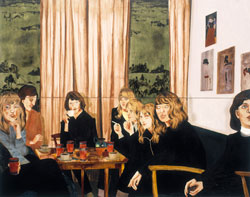Mamma Andersson

It’s old news that Karin Mamma Andersson is a raconteur, and so it’s nice to find out that she has created pictures for three Nobel prizewinners for literature – Elfriede Jelinek, Harold Pinter and, recently, Orhan Pamuk – which accompany the decrees naming them laureates. For Pinter, Andersson created one of her deserted interiors. As insipidly real as they come, it fittingly brings to mind Pinter’s play The Room (1957). Writing in the Sunday Times following the première of The Room at the Bristol Old Vic Theatre School, Harold Hobson described the Michael Ackland set as an ‘excellent . . . exercise in realism’, and the same should be said for Andersson’s interior. The serendipitous comparison doesn’t end there, however. The conclusion of Hobson’s favourable review, with its comment that Pinter’s plot did ‘not admit of precise solutions’, could equally well have been summing up Andersson’s retrospective. Like Pinter’s, Andersson’s is an art of loose ends and unanswered questions.
If Hobson’s appraisal of Pinter is appropriate also to Andersson, then Clement Greenberg’s feelings for Edward Hopper are equally applicable: if Hopper ‘were a better painter’, Greenberg reasoned, ‘he would, most likely, not be so superior an artist.’ In her works Andersson has gleaned everything she can from the likes of Dick Bengtsson, Henry Darger and Nils von Dardel, but her own painting style has remained apathetic: callow drawing and acrid colour scrubbed into canvases. Yet if there are few confections to delight the eye, there is much to ponder. Take, for example, Andersson’s Gone for Good (2006), another mind-numbing Swedish interior, where a matching pink velveteen couch and easy chair are parked in front of a TV festooned with one of those saccharine dolls that people collect. A standard-issue landscape provides a touch of highbrow élan. The scene would test positive for ennui, but there is no ignoring the fact that the pink couch has inexplicably caught fire as only polyester can (Andersson is sensitive to detail). With no one home to grab the garden hose and stem the tide of tragedy, she leaves us as witnesses to ruin. Is this heart-breaking calamity autobiographical too? Is it a set piece of homeland creepiness à la David Lynch? Or are we beholding Andersson’s scorched-earth policy towards the torpor of life among the humbler classes? Like much of her work, Gone for Good resists any attempt at deduction. To what end? Again, she side-steps any conclusion.
Andersson does provide occasional direction-finding clues, though, and these tend to come in three flavours: fable, pop music and art history. Touchstones include Edvard Munch, Alice in Wonderland, Edward Hopper, The Beatles, Snow White, Kurt Cobain and Pablo Picasso. Arguably her masterpiece is About a Girl (2005), a picture of nine women cosily chatting at a coffee social. The composition captures a moment, like an ill-conceived snapshot. Smallish pin-ups of geisha woodcuts and Disney’s Snow White form a constellation on a wall above the clatter at the kaffeeklatsch. About a Girl is also the title of a Kurt Cobain song: ‘I need an easy friend . . . But I can’t see you every night free.’ Cobain, plaintively resisting the commitment that would save a wobbling relationship, abets Andersson in framing love’s uncertainty against the unconditional love that Snow White could take for granted. It wasn’t enough that she had her prince; even Bashful secretly had a crush on her too. The closing act of this opera buffa is carried off by the geishas, archetypes of feminine perfection, who provide the garnish for Andersson’s chaotic cocktail of love won and lost; shaken, not stirred. ‘Love won and lost’: this thread of interpretation, like every account of Andersson’s artistic plot, is an extemporized affair, without purchase on anything decisive, much less precise.
When all’s said and done, Andersson’s retrospective reveals a forceful artistic temperament and is, within its own parameters, unreservedly abundant. The question is about how limiting those parameters may become. In 1928 Picasso assembled his virtuoso Head, a thematic self-portrait materializing as assorted variations, including L’artiste et son modèle (The Artist and His Model). This is a post-Cubist Picasso – with halo – contemplating tentative forays into the new world called Surrealism. The sculpture’s appearance marks a decisive moment that, once taken, would drive him on to profoundly new masterpieces, among them the weeping women pictures. Head guest-stars in Andersson’s Modern Views (2000), her panorama of a desolate landscape and monstrous, foreboding clouds. A premonition of upheaval, like Rembrandt’s Stormy Landscape (c.1638), Andersson’s painting puts its arms around precipitate change, but, judging from this exhibition, it seems unlikely that she will ever embrace it like Picasso.
Often our habit in retrospectives is to seek turning-points, judging them as preludes to artistic conversions. Preludes are scarce in Andersson’s retrospective. Isn’t a prelude a conclusion of sorts, occupying the threshold of what’s to come? Andersson, her art tells us, circumnavigates conclusions and seems happiest when unanswered questions are what she leaves behind.















